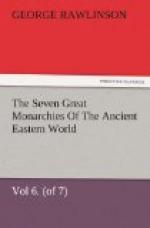On the whole, the Turanian character of the Parthians, though not absolutely proved, appears to be in the highest degree probable. If it be accepted, we must regard them as in race closely allied to the vast hordes which from a remote antiquity have roamed over the steppe region of upper Asia, from time to time bursting upon the south, and harassing or subjugating the comparatively unwarlike inhabitants of the warmer countries. We must view them as the congeners of the Huns, Bulgarians, and Comans of the ancient world; of the Kalmucks, Ouigurs, Usbegs, Eleuts, etc., of the present day. Perhaps their nearest representatives will be, if we look to their primitive condition at the founding of their empire, the modern Turkomans, who occupy nearly the same districts; if we regard them in the period of their great prosperity, the Osmanli Turks. Like the Turks, they combined great military prowess and vigor with a capacity for organization and government not very usual among Asiatics. Like them, they remained at heart barbarians, though they put on an external appearance of civilization and refinement. Like them, they never to any extent amalgamated with the conquered races, but continued for centuries an exclusive dominant race, encamped in the countries which they had overrun.
The circumstances under which the Parthians became subjects of the Persian empire may readily be conjectured, but cannot be laid down positively. According to Diodorus, who probably followed Ctesias, they passed from the dominion of the Assyrians to that of the Medes, and from dependence upon the Medes to a similar position under the Persians. But the balance of evidence is against these views. It is, on the whole, most probable that neither the Assyrian nor the Median empire extended so far eastward as the country of the Parthians. The Parthians probably maintained their independence from the time of their settlement in the district called after their name until the sudden arrival in their country of the great Persian conqueror, Cyrus. This prince, as Herodotus tells us, subdued the whole of Western Asia, proceeding from nation to nation, and subjugating one people after another. The order of his conquests is not traceable; but it is clear that after his conquest of the Lydian empire (about B.C. 554) he proceeded eastward, with the special object of subduing Bactria.43 To reach Bactria, he would have to pass through, or close by, Parthia. Since, as Herodotus says, “he conquered the whole way, as he went,” we may fairly conclude that on his road to Bactria he subjugated the Parthians. It was thus, almost certainly, that they lost their independence and became Persian subjects. Competent enough to maintain themselves against the comparatively small tribes in their near neighborhood, the Chorasmians, Hyrcanians, Arians of Herat, Bactrians, and Sagartians, it was not possible for them to make an effectual resistance to a monarch who brought against them the entire force of a mighty




